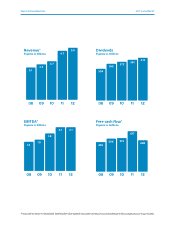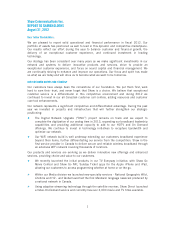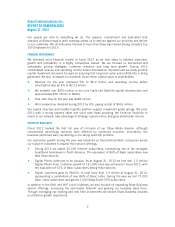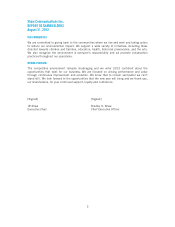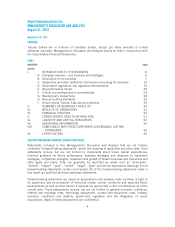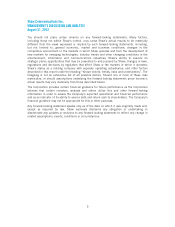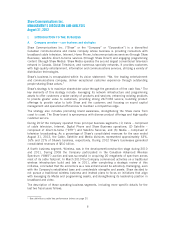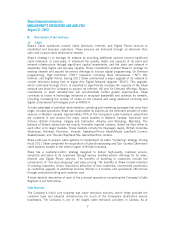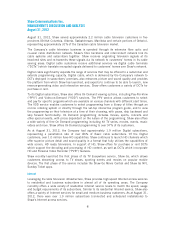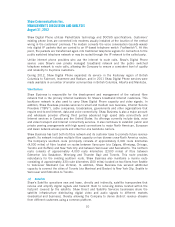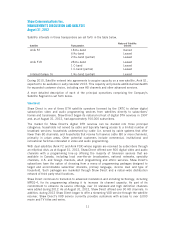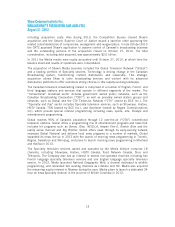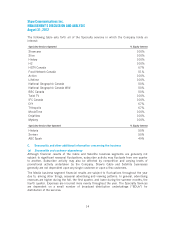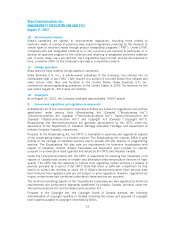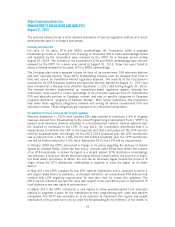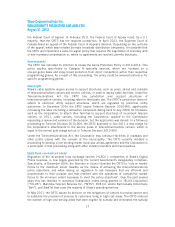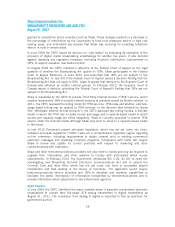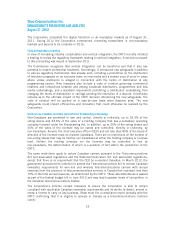Shaw 2012 Annual Report Download - page 14
Download and view the complete annual report
Please find page 14 of the 2012 Shaw annual report below. You can navigate through the pages in the report by either clicking on the pages listed below, or by using the keyword search tool below to find specific information within the annual report.Shaw Communications Inc.
MANAGEMENT’S DISCUSSION AND ANALYSIS
August 31, 2012
Shaw Digital Phone utilizes PacketCable technology and DOCSIS specifications. Customers’
existing phone lines are connected into modems usually installed at the location of the central
wiring in the customers’ premises. The modem converts the voice conversation (sounds waves)
into digital IP packets that are carried to an IP-based telephone switch (“softswitch”). At this
point, the packets are transformed again into traditional telephone signals for connection to the
public switched telephone network or may be routed through the IP network to the called party.
Unlike internet phone providers who use the internet to route calls, Shaw’s Digital Phone
service uses Shaw’s own private managed broadband network and the public switched
telephone network to route calls, allowing the Company to ensure a consistent level of quality
and reliability to its phone customers.
During 2012, Shaw Digital Phone expanded its service in the Kootenay region of British
Columbia to Fairmont, Invermere and Radium, and in 2011 Shaw Digital Phone services were
made available in a number of smaller communities in British Columbia, Alberta and Manitoba.
Shaw Business
Shaw Business is responsible for the development and management of the national fibre
network that is the primary Internet backbone for Shaw’s broadband Internet customers. This
backbone network is also used to carry Shaw Digital Phone capacity and video signals. In
addition, Shaw Business provides services to small and medium size business, Internet Service
Providers (“ISPs”), cable companies, broadcasters, governments and other organizations that
require end-to-end Internet, data and voice connectivity. Shaw Business is also a major account
and wholesale provider offering third parties advanced high speed data connectivity and
Internet services in Canada and the United States. Its offerings currently include data, voice
and video transport and Internet connectivity services. It also continues to establish public and
private peering arrangements with high speed connections to major North American, European
and Asian network access points and other tier-one backbone carriers.
Shaw Business has built both its fibre network and its customer base to promote future revenue
growth. Its network includes multiple fibre capacity on two diverse cross-North America routes.
The Company’s southern route principally consists of approximately 6,400 route kilometres
(4,000 miles) of fibre located on routes between Vancouver (via Calgary, Winnipeg, Chicago,
Toronto and Buffalo) and New York City and between Vancouver and Sacramento. The northern
route consists of approximately 4,000 route kilometres (2,500 miles) of fibre between
Edmonton (via Saskatoon, Winnipeg and Thunder Bay) and Toronto. This route provides
redundancy for the existing southern route. Shaw Business also maintains a marine route
consisting of approximately 330 route kilometres (200 miles) located on two fibres from Seattle
to Vancouver Mainland (via Victoria). In addition, Shaw Business has secured additional
capacity to connect the cities of Toronto (via Montreal and Boston) to New York City, Seattle to
Vancouver and Edmonton to Toronto.
(ii) Satellite
Shaw’s Satellite operations own and lease, directly and indirectly, satellite transponders that
receive and amplify digital signals and transmit them to receiving dishes located within the
footprint covered by the satellite. Shaw Direct and Satellite Services businesses share the
satellite infrastructure distributing digital video and audio signals to different markets
(residential and business), thereby allowing the Company to derive distinct revenue streams
from different customers using a common platform.
10


